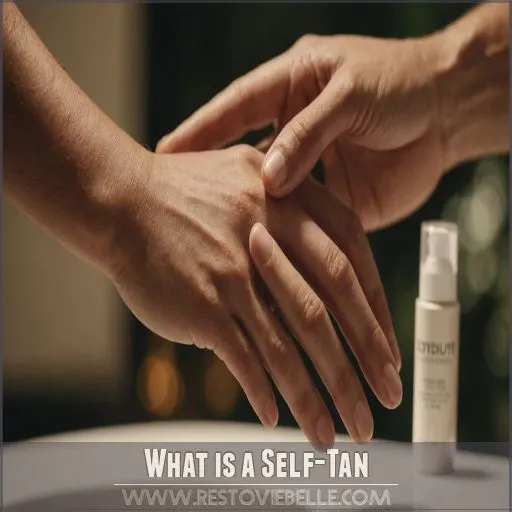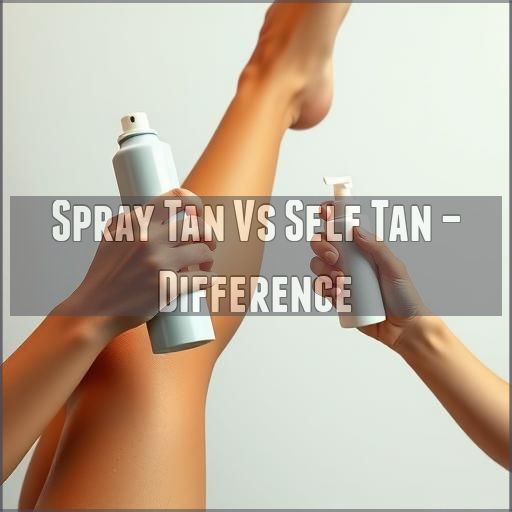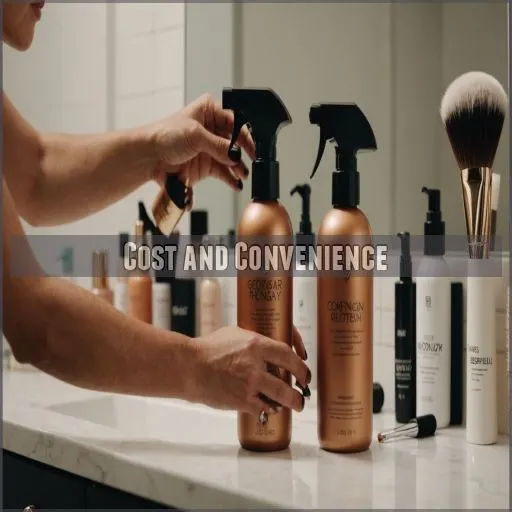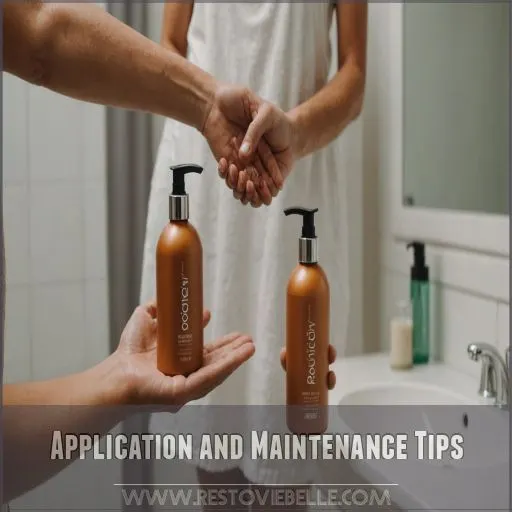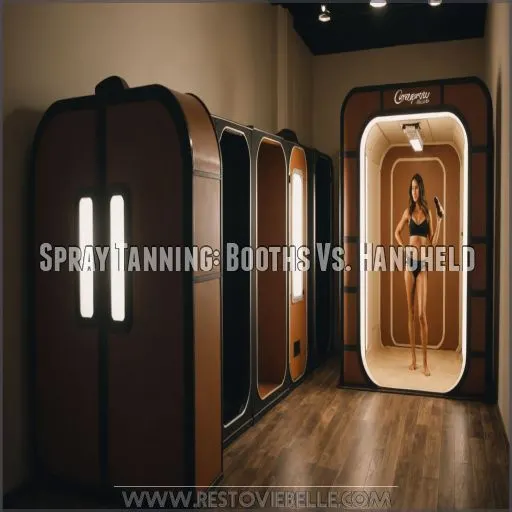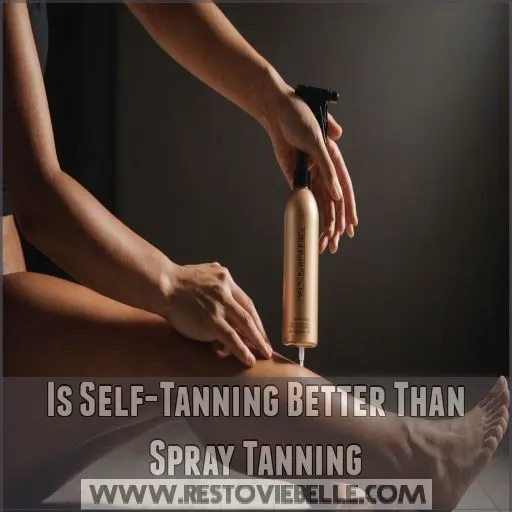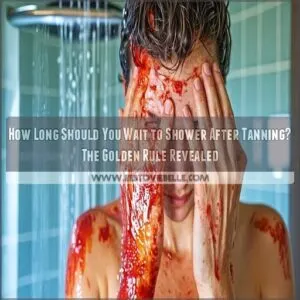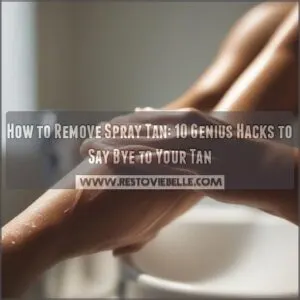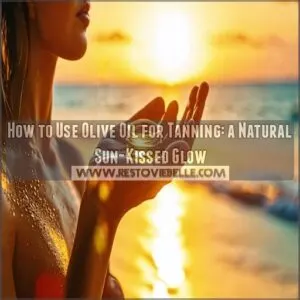This site is supported by our readers. We may earn a commission, at no cost to you, if you purchase through links.
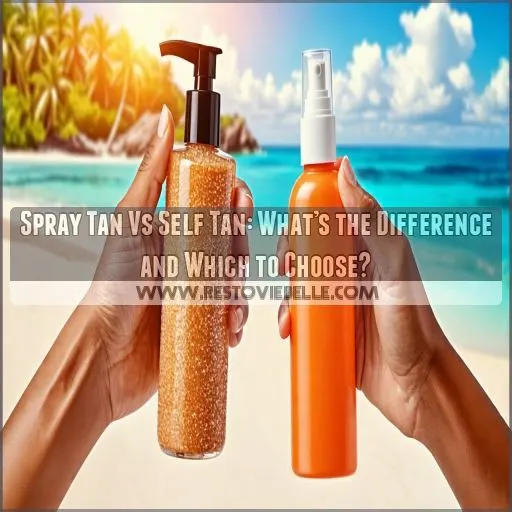 Choosing between a spray tan and a self-tan might feel like deciding between a fancy coffee or a homemade brew.
Choosing between a spray tan and a self-tan might feel like deciding between a fancy coffee or a homemade brew.
Spray tans offer quick and flawless results, perfect when you’re short on time but big on glow, though they can dent your wallet a bit.
Self-tanning puts you in control, letting you decide when and where to apply, all while keeping costs down. Sure, it takes a little more prep and patience, but you’ve got this!
Whether you prefer the salon’s magic mist or your own DIY skills, each has its perks. Stay tuned for tips to perfect your choice!
Table Of Contents
- Key Takeaways
- What is a Spray Tan
- What is a Self-Tan
- Spray Tan Vs Self Tan – Difference
- Results and Effectiveness
- Cost and Convenience
- Application and Maintenance Tips
- Spray Tanning: Booths Vs. Handheld
- Is Self-Tanning Better Than Spray Tanning
- Frequently Asked Questions (FAQs)
- Is self tanning better than spray tanning?
- How does coconut milk help remove tan?
- Should I spray tan If I don’t have a self-tanner at home?
- Is spray tanning a good option?
- Is it better to self tan or get a spray tan?
- Does a spray tan last longer than self tan?
- Is it worth getting a spray tan?
- How long do spray tans last?
- Can spray tans be harmful to sensitive skin?
- Are there safety concerns for pregnant individuals using a spray tan?
- How long does a self-tan typically last?
- Does spray tanning provide sun protection?
- Can self-tanners cause skin irritation or allergies?
- Conclusion
Key Takeaways
- You’re in the driver’s seat with self-tanning, applying at home whenever you want, while spray tans offer a quick pro glow-up at the salon – it’s like choosing between cooking or ordering takeout for your skin.
- Your wallet will thank you for self-tanning in the long run, but remember, you’re trading cost for convenience – spray tans may cost more per session, but they’re like a personal chef whipping up a perfect tan in minutes.
- Don’t sweat it if you’re not a DIY pro – spray tans give you even coverage without the streaky learning curve, but self-tanning lets you fine-tune your glow over time like a tanning Picasso.
- Both options typically last about a week, but you’ll need to baby your spray tan to make it stick around – think of it like a houseplant that needs the right care, while self-tans are more like succulents, forgiving if you forget a touch-up.
What is a Spray Tan
A spray tan is your ticket to that sun-kissed glow without the sun’s harmful rays.
Using a professional or in a booth, a spray tan is achieved with a fine mist.
It might sound like magic, but it’s really just a smart mix of skill and science that leaves you looking like you’ve just returned from a tropical getaway.
Definition of a Spray Tan
A spray tan is a quick and convenient way to achieve a sun-kissed glow without exposing your skin to harmful UV rays.
This sunless tanning method involves a fine mist of DHA-infused solution being sprayed onto your body, which interacts with the amino acids in your skin to temporarily darken your complexion.
How Spray Tanning Works
You’ve grasped the basics of a spray tan, so how does it actually work?
It’s all about the magic of DHA, a colorless sugar in the spray tan solution.
It reacts with your skin’s amino acids, creating a golden hue.
Whether through a spray tanning booth or a handheld device, the tanning solution ingredients are key to that sun-kissed look.
Benefits of Spray Tanning
Imagine stepping into a tanning salon and coming out with an even tan that’s long-lasting and kind to your skin. Spray tanning offers magic in a bottle, with a professional touch that enhances your natural glow.
- Even Tan: Flawless, streak-free results.
- Long-Lasting: Keeps you radiant for days.
- Skin Health: UV-free, skin-safe.
- Customized Glow: Matched to your tone.
Types of Spray Tanning (Booths Vs. Handheld)
Choosing a spray tan means considering booths and handheld options.
With booths, you’re stepping into a tanning salon’s private pod; no stress about technician skills, just follow simple voice-guided steps for even spray tan coverage (Source).
Prefer a personal touch? Handheld airbrush gives you custom shades, with a technician ensuring perfect application tips, although it requires more time.
How to Prepare for a Spray Tan
Before stepping into the booth or under a handheld spray tan, remember preparation’s key! Exfoliate your skin to get an even tone. Moisturize daily but skip it on the appointment day. Remove any hair 24 hours before the session. Finally, avoid beauty products that could block the tan.
- Exfoliate regularly
- Moisturize daily
- Hair removal 24 hours prior
- No lotions day of
What is a Self-Tan
Guess what?
With a self-tan, you’re the boss, using at-home products like mousse or lotion to get that sunny glow without stepping outside.
Plus, no weird tan lines from falling asleep in the sun.
Definition of a Self-Tan
So, you’ve explored spray tans, but what about self-tanning?
Self-tanning gives you the power to achieve that sun-kissed glow without stepping outside.
Using self-tanners like foams, lotions, and wipes, you apply a product containing DHA, which reacts with your skin to create a bronzed look.
Think of it as crafting your own golden hue with full control over the process.
How Self-Tanning Works
Self-tanning products use the active ingredient DHA to create a temporary "tan" by reacting with the amino acids in the top layer of your skin.
This chemical reaction produces melanoidins, which mimic the look of a natural tan without any UV exposure.
Just apply the product evenly, let it dry, and voila – a sun-kissed glow!
Benefits of Self-Tanning
Imagine self-tanning as your ticket to a sun-kissed glow without the hassle. It’s cost-effective and happens right at home, skipping those salon appointments.
Here’s why you’ll love it:
- Convenience: Apply anytime.
- Long-lasting results: Enjoy days of bronzed bliss.
- Control: Customize your tan.
- Easy application: Like spreading peanut butter on toast!
Types of Self-Tanning Products (Mousse, Lotion, Serum, Wipes)
Explore the self-tanning world with mousse, lotion, serum, and wipes.
Mousse gives you quick drying time, ideal for busy bees.
Lotion offers a hydrating glow, while serum targets tanning and skin care with anti-aging benefits.
Wipes are your travel buddy—compact and handy.
That depends on your tanning session needs and lifestyle!
How to Apply Self-Tanner
Once you’ve chosen your self-tanning product, prep by exfoliating and moisturizing dry spots like knees and elbows.
Ready to glow? Use a tanning mitt for even coverage and say goodbye to over-tanned hands.
Apply in circular motions, avoiding self-tanner mistakes.
Let your tan dry completely before dressing, ensuring a flawless, natural look, just like pros do.
Spray Tan Vs Self Tan – Difference
Picking between a spray tan and a self-tan can feel like choosing between takeout and a homemade meal—both give you a sun-kissed glow, but the process and price differ.
Spray tans offer quick and professional results at a higher cost, while self-tanning demands a little more effort but saves you some cash, making it a more budget-friendly self-tan option.
Price Comparison (Spray Tan Vs. Self-Tan)
Choosing between a spray tan and self-tanning products can be tricky.
Let’s talk dollars and cents. Spray tans, especially airbrush services, can cost $25 to $100 per session.
Self-tanning products, like mousses and lotions, typically range from $10 to $35. If you’re on a budget, self-tanning is your cheapest solution, offering more bang for your buck!
Speed of Application (Spray Tan Vs. Self-Tan)
Saving time on tanning? Spray tans are your fast-track ticket to bronzed glory, as a quick trip to the salon delivers an even glow within minutes, thanks to booth efficiency.
Self-tanning at home? It’s a different ball game; you’ll need extra prep and patience. Perfect for controlling the process, but it’s not the speediest route.
Ease of Application (Spray Tan Vs. Self-Tan)
Applying a spray tan is a breeze – just stand still and let the professionals work their magic.
But self-tanning requires a bit more elbow grease. You’ll need to thoroughly prepare your skin by exfoliating 24 hours beforehand to remove dead skin cells and create a smooth surface.
You’ll then need to moisturize 12-24 hours before applying self-tanner with an oil-free, hydrating lotion.
You’ll then need to use a mitt or gloves to avoid streaky palms. Carefully blend the formula, especially on tricky areas like your back, for a flawless, natural-looking glow.
Duration of Tan (Spray Tan Vs. Self-Tan)
A spray tan lasts around one week, fading as naturally as a beach sunset, while self-tan can linger up to ten days with touch-ups.
Factors affecting duration include your skin type, product quality, and lifestyle impacts.
So, weigh your options based on convenience and tan longevity. A tan doesn’t last forever, but the memories might!
| Aspect | Spray Tan | Self-Tan |
|---|---|---|
| Duration | 5-7 Days | 7-10 Days |
| Skin Type Impact | Moderate | Moderate |
| Lifestyle Impact | High | Medium |
Maintenance and Upkeep (Spray Tan Vs. Self-Tan)
Spray tans typically last longer but demand commitment. Avoid showering immediately after, and stick to loose clothing for better results.
Regular moisturizing extends its life.
Self-tan maintenance can feel like a juggling act—exfoliate lightly and moisturize often to prevent faster fading.
Balancing upkeep with the desire for a long-lasting glow is a small price for tan-tastic skin freedom!
Results and Effectiveness
Wondering which tanning method delivers the best glow?
Let’s weigh the results and effectiveness of spray tans versus self-tans, so you can choose the perfect sun-kissed look without the UV rays.
Spray Tan Results and Effectiveness
Considering a spray tan? It’s like gifting yourself a perfect, sun-kissed glow without the beach time. Expect that bronzed look to last 5-10 days, but remember, improper aftercare can send it packing sooner.
To maximize your results, be sure to prepare your skin beforehand by exfoliating 5-8 days prior and hydrating with lotion daily.
Follow tips faithfully: exfoliate, stay hydrated, and avoid common tanning mistakes to keep your glow alive and kicking.
Who needs a tropical vacation, anyway?
Self-Tan Results and Effectiveness
After a spray tan’s allure, let’s chat about self-tan results.
Self-application can lead to some killer streaks if you’re not careful, but the self-tan color is adjustable to your vibe—light to dark.
With a bit of care, it can last impressively long. Just remember, every tan fades, so mind the application to keep glowing! (Source)
Comparison of Spray Tan and Self-Tan Results
You’re choosing between two paths to a golden glow.
With spray tans, expect longer-lasting results and even color consistency—perfect for big events. Self-tans offer freedom with at-home application and cost savings, but watch out for streak risks!
Both fade around two weeks.
Remember, regardless of your choice, moisturize to prolong that gorgeous bronze.
Factors Affecting Tan Results (Skin Type, Application Method, Maintenance)
Your skin type, how you apply the tanning product, and how you maintain it all play a big role in your final results.
Lighter skin types may develop a deeper bronze, while darker complexions may see a more subtle glow.
Proper exfoliation, following application instructions, and avoiding excessive washing can help extend the life of your tan.
Cost and Convenience
Thinking about your glow-up options?
In terms of cost and convenience, choosing between a spray tan and a self-tanner is like deciding between a pampering salon splurge and a quick DIY fix at home.
Both have their perks and pitfalls, just depends if you’re ready for some lazy self-care or need speedier results on a budget.
Cost of Spray Tanning
Considering how fabulous you want to look, spray tan prices might just leave a dent in your wallet. Salon pricing varies widely, with costs influenced by location and technique.
Embrace freedom in your budget planning with these tips:
- Compare prices at different salons for budget-friendly options.
- Look for deals or group discounts.
- Ask about packages for regular visits.
Cost of Self-Tanning
Why pay for spray tans when self-tanning offers budget-friendly options for a sun-kissed glow right at home?
Explore DIY tanning with popular self-tanner brands and compare costs easily.
Below, see how costs stack up:
| Product Type | Average Cost |
|---|---|
| Mousse | $10-$25 |
| Lotion | $8-$20 |
| Serum | $15-$30 |
| Wipes | $7-$15 |
It’s a wallet-friendly way to stay bronzed!
Convenience of Spray Tanning (Salon Appointments)
At a salon, spray tanning offers appointment flexibility and booking ease that’s downright dreamy.
Imagine saving time with a quick spray session instead of wrestling with at-home kits. Although you’ve got to account for traveling time, a professional touch guarantees even coverage with minimal hassle.
Salon scheduling lets you manage your time commitment, feeling bronzed without breaking a sweat!
Convenience of Self-Tanning (At-Home Application)
Self-tanning at home puts you in the driver’s seat—no appointments, just your schedule. It’s a quick tan fix that’s easy on the wallet.
Here’s why it’s a time-saving option:
- Self-tanner tips are simple to follow.
- A DIY guide adds freedom and customization.
- Enjoy your home tan routine whenever suits you.
Stay golden, effortlessly!
Time Commitment for Each Option
Juggling spray tan appointments can feel like trying to schedule a coffee date with a busy friend—it requires careful planning.
You’ll need time for prep, the appointment, and drying, which can take several hours (Source).
Additionally, if you’re looking to remove your spray tan, you may want to think about the time commitment for removing stubborn spray tan, which can involve exfoliation methods, oil-based removal methods, and heat-based removal methods that need to be done carefully to avoid skin irritation.
On the flip side, self-tanning offers more control but demands patience in application and maintenance, taking up your evenings like a new binge-worthy series.
Application and Maintenance Tips
Getting that perfect, sun-kissed glow is a breeze with a little prep work.
Whether you opt for a spray tan or self-tanner, be sure to exfoliate and moisturize beforehand for the most even, long-lasting results.
And don’t forget to avoid water and sweat for a few hours after application – your tan will thank you, and enjoy the long-lasting results.
Pre-Application Tips (Exfoliation, Moisturizing)
Prepping for tanning is essential!
Start with a good exfoliating tool to banish dead skin cells, avoiding pesky patchiness. Think of it as sweeping the floor before laying a new carpet—smooth is the goal!
Follow up with the right moisturizer type; lightweight ones work wonders for your skin care routine.
Don’t fall for tanning myths; prep makes perfection!
Post-Application Tips (Avoiding Water, Sweating)
After you’ve exfoliated and moisturized like a pro, remember to avoid water and sweating for at least eight hours.
Think of it as giving your tan its beauty sleep. This will help prevent tan streaks and help your tan last longer.
So, put away the workout gear and cooking apron for now, and let your radiant glow take center stage! .
Tips for Maintaining a Spray Tan
Your spray tan’s staying power hinges on a few simple tricks. To prevent fading, it’s best to use tepid water instead of hot when showering and gently pat your skin dry. Keep showers short and sweet to prevent fading.
Moisturize daily with an oil-free option to lock in that golden glow. Learn more about spray tan care.
Skip exfoliating until you’re ready for a fresh tan. And remember, too much sun exposure can mess with your color, so shade’s your new best friend!
Tips for Maintaining a Self-Tan
Looks like you’ve mastered the spray tan game. Now, let’s tackle self-tanning to keep that glow on lock!
Here’s how to prevent those pesky self-tanning mistakes:
- Exfoliate regularly to avoid patchiness.
- Moisturize daily for long-lasting color.
- Touch up every 3-4 days with a gradual tanner.
- Avoid hot showers, as they make your tan fade faster.
Spray Tanning: Booths Vs. Handheld
When you’re thinking about spray tanning, you might be torn between the option of stepping into a booth or getting that personalized touch with a handheld airbrush.
Each has its perks: booths offer speed and privacy, while handheld tanning gives you that customized look, though it can depend a bit on the technician’s skills.
Benefits of Booths (Convenience, Even Coverage)
Imagine stepping into a spray tan booth—it’s like a private vacation, instantly delivering a sun-kissed glow. Booths offer you privacy and quick, even coverage without any hassle. They’re cost-effective and safe, giving consistent results every time.
Here’s a quick glance:
| Aspect | Benefit |
|---|---|
| Privacy | Personal space is guaranteed |
| Speed | Done in minutes |
| Cost | Value for experience |
| Results | Uniform tan |
| Safety | Regulated environment |
Drawbacks of Booths (Limited Customization)
While spray tan booths offer convenience and even coverage, they come with a major drawback – limited customization.
You’re stuck in a one-size-fits-all setup, unable to target specific areas or adjust the color to your liking. That means you might end up with an uneven tan or require multiple touch-ups.
For a truly custom spray, a handheld session is the way to go.
Benefits of Handheld (Customization, Control)
With limited customization in booths, handheld airbrush techniques shine through.
You have full control over the process, perfect for spray tan artistry enthusiasts.
Enjoy:
- Personalized tanning that matches your skin tone.
- Precise application ensuring no missed spots.
- Contouring expertise to highlight your best features.
It’s your canvas, and handheld gives you the brush.
Drawbacks of Handheld (Time-Consuming, Skill-Dependent)
Handheld spray tanning is like painting a masterpiece—you need an experienced artist, and it demands a serious time investment. Uneven results lurk if your technician isn’t skilled.
Check out this quick comparison:
| Aspect | Handheld |
|---|---|
| Time Needed | High |
| Skill Required | High |
| Customization | Excellent |
| Cost | Variable |
| Results | Personalized |
Is Self-Tanning Better Than Spray Tanning
Deciding between self-tanning and spray tanning can feel like choosing between chocolate and vanilla ice cream—both have their perks.
Perhaps self-tanning is your best option if you crave control and flexibility. Here’s why it might tick all your boxes:
- Cost-effective: One bottle provides several applications, saving you some cash.
- Convenience: You can apply it whenever you want—say goodbye to salon schedules.
- Ease of application: Many products offer simple, mess-free solutions such as mousses and wipes.
- Maintenance: Regular touch-ups with self-tanner help maintain that glow without hassle.
So, if freedom and a wallet-friendly tan are what you’re after, self-tanning just might be your tan-mate!
Frequently Asked Questions (FAQs)
Is self tanning better than spray tanning?
About 30% of people prefer the convenience of self-tanning at home since it fits any schedule and saves money.
While spray tans offer quick, even results, they’re pricier and require appointments.
Choose what suits your lifestyle best.
How does coconut milk help remove tan?
Coconut milk’s natural bleaching agents can help lighten sun tan and even out skin tone over time.
Just soak a cotton ball in it, apply, and rinse – it’s a simple, nourishing way to restore your glow.
Should I spray tan If I don’t have a self-tanner at home?
If you lack self-tanner at home, going for a spray tan can be a smart move.
A pro guarantees even coverage and avoids the dreaded orange streaks.
Just remember, you’ll need to schedule it.
Is spray tanning a good option?
Spray tanning’s a handy option if you want a quick, even glow without UV exposure.
Perfect for big events, it’s hassle-free, though pricier than self-tan.
Just remember, sweating can fade the tan quickly.
Is it better to self tan or get a spray tan?
Choosing between self and spray tans depends on your lifestyle and budget.
Self-tanning offers flexibility at home, while spray tans provide a flawless, quick result for special occasions.
Either way, you’ll skip those harmful UV rays.
Does a spray tan last longer than self tan?
You might find a spray tan lasts a little longer than a self tan, typically about 7-10 days.
Skin naturally sheds every two weeks, so either method will eventually fade away like sand through your fingers.
Is it worth getting a spray tan?
Thinking of a sun-kissed glow without the sunburn?
A spray tan’s worth it if you crave a quick, even tan for a special event.
Just be ready for some upkeep, and maybe skip the white outfits.
How long do spray tans last?
A spray tan usually sticks around for 7 to 10 days, depending on your skin tone and care routine.
Lighter shades may fade faster, while darker tones last longer.
To stretch its lifespan, follow after-care tips.
Can spray tans be harmful to sensitive skin?
While spray tans are generally safe, they may pose risks for those with sensitive skin.
Consult your dermatologist before getting a spray tan, as the chemicals could potentially cause irritation or allergic reactions.
Patch test to make sure your skin tolerates the formula, it is a way to Patch test before using the formula on your entire body.
Are there safety concerns for pregnant individuals using a spray tan?
Expectant parents might wonder about spray tan safety.
Generally, DHA’s okay for skin use, but take extra care not to inhale it.
Consider using nasal protection and make sure there’s good ventilation during the process for peace of mind .
How long does a self-tan typically last?
Like a fading daguerreotype, your self-tan’s golden glow typically lasts about a week.
You’ll notice it start to fade around day 5, but don’t fret—you can always reapply to keep that sun-kissed look going strong.
Does spray tanning provide sun protection?
Don’t be fooled by that bronze glow!
Spray tans offer minimal sun protection, with an SPF of only 1-
You’ll still need sunscreen to shield your skin from harmful UV rays.
Stay safe and sun-smart!
Can self-tanners cause skin irritation or allergies?
Self-tanners can indeed trigger skin irritation or allergies in some folks.
You might experience redness, itching, or rashes.
To play it safe, do a patch test first and choose products suited for your skin type.
Always follow application instructions carefully.
Conclusion
Whether you’re a sun-kissed goddess or a bronzing novice, the choice between spray tan vs self tan boils down to your lifestyle and preferences.
Both options offer a safer alternative to baking in the sun.
Spray tans provide quick, professional results, while self-tanning gives you control and saves money.
Whichever you choose, remember: practice makes perfect. Embrace your glow journey, experiment with techniques, and find what works best for you.
After all, confidence is the most attractive accessory you can wear!


